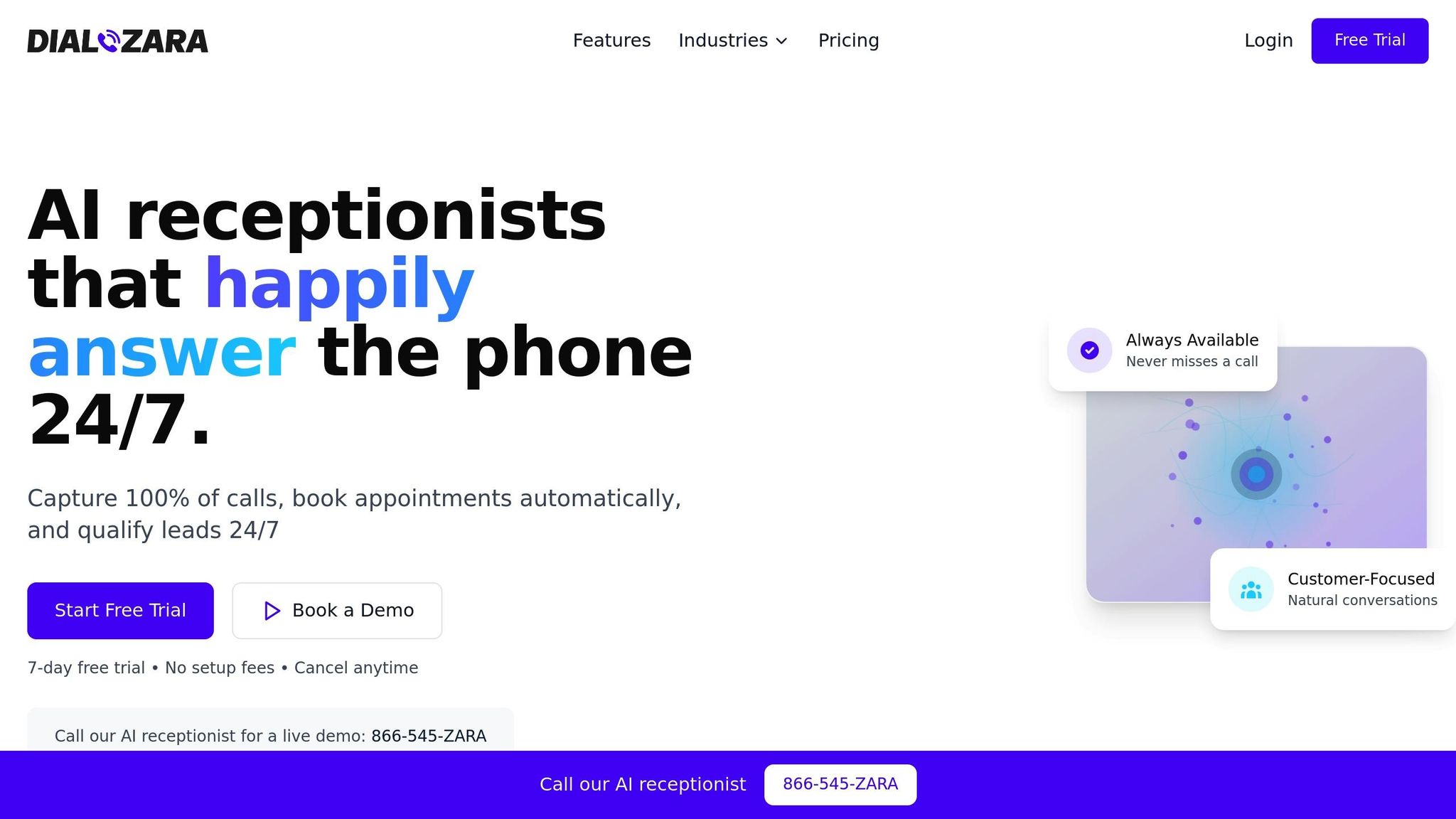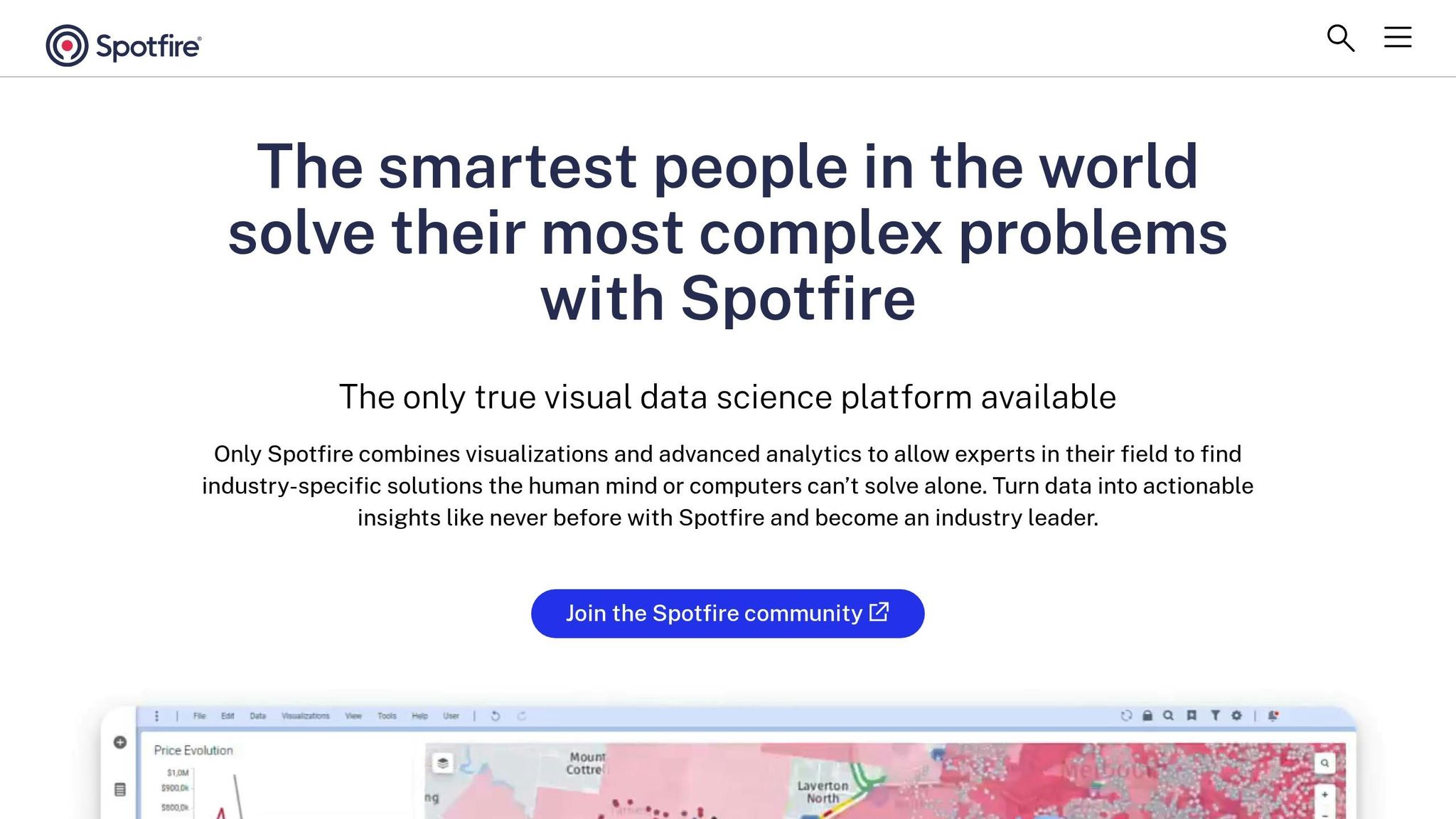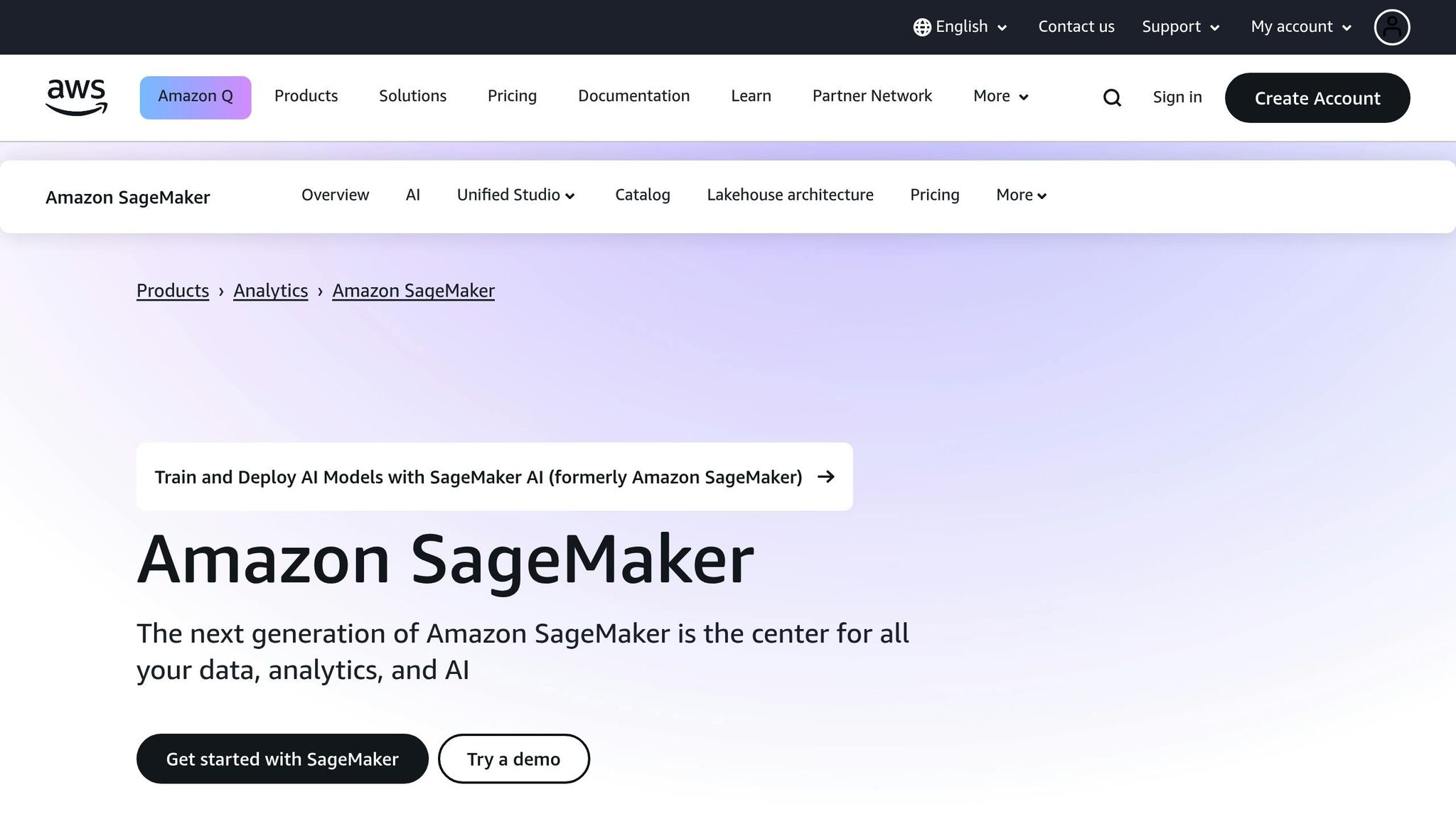
Best AI Platforms for Telecom Data Analytics
The U.S. telecommunications industry is increasingly relying on AI to manage complex networks, improve customer retention, and analyze market trends. With 90% of telecom companies using AI (Nvidia, 2024), the global market is projected to grow from $2.36 billion in 2023 to $58.74 billion by 2032 at a 43.1% annual rate. North America leads this growth, holding 35% of the market.
This article reviews four AI platforms tailored for telecom companies:
- Dialzara: Specializes in customer interaction analytics with voice AI and seamless integrations.
- TIBCO Spotfire: Focuses on advanced data visualization and predictive analytics.
- Amazon SageMaker: Offers a complete machine learning workflow for large-scale data operations.
- T-Mobile IntentCX: A real-time AI platform designed for telecom-specific challenges, currently in testing.
Quick Comparison
| Platform | Strengths | Limitations | Pricing Highlights |
|---|---|---|---|
| Dialzara | Voice AI, 24/7 availability, cost-efficient | Limited to voice analytics, SMB-focused | $29–$199/month, 7-day free trial |
| TIBCO Spotfire | Predictive insights, real-time dashboards | High cost, steep learning curve | $25–$3,000/user, SaaS starts at $200/mo |
| Amazon SageMaker | Scalable ML tools, AWS integration | Complex pricing, AWS-dependent | Pay-as-you-go, free tier available |
| T-Mobile IntentCX | Telecom-specific real-time insights | Limited availability, pricing TBD | Not disclosed |
Each platform has unique advantages depending on your business size, budget, and goals. Dialzara is ideal for smaller operators needing customer service automation, while SageMaker and Spotfire cater to enterprises with large-scale data needs. T-Mobile IntentCX is a promising option for telecom-specific solutions, though details are still emerging.
Keep reading for detailed insights into each platform’s features, integrations, and pricing.
1. Dialzara

Dialzara might be best known as an AI-powered virtual phone answering service, but its capabilities go much further. It also provides telecom companies with advanced tools for analyzing customer interactions through detailed communication tracking. This makes it a powerful ally for improving customer service operations while uncovering actionable insights from customer conversations.
AI/ML Features
Dialzara's AI technology does more than just answer calls - it transforms how businesses manage customer interactions. Using advanced AI voice technology, the platform adapts to industry-specific terminology and customer tones. This ability to adjust dynamically is especially valuable for telecom companies that handle a variety of technical support calls and customer queries.
The AI continuously learns and improves, boosting service quality while extracting meaningful insights from conversations. Plus, it integrates seamlessly with existing systems, making it easy to adopt without disrupting current workflows.
Data Integration
One of Dialzara's standout features is its ability to integrate with a wide range of systems. It connects with more than 5,000 business applications and works effortlessly with telecom infrastructures. This makes it simple for companies to incorporate Dialzara into their existing tech ecosystem.
Beyond integration, it offers detailed call transcripts, recordings, and instant notifications. These tools allow telecom companies to analyze communication patterns effectively and monitor service quality metrics with precision.
Telecom-Specific Analytics
Dialzara is equipped with features tailored specifically for the telecom industry. It can handle multiple calls at the same time, ensuring no data is lost during peak periods or service interruptions. Its message-taking capabilities, complete with customizable questions, help gather targeted information on service issues, customer satisfaction, or technical challenges.
The platform also excels in call screening, categorizing interactions to flag urgent issues and track recurring problems. This categorization not only highlights areas needing immediate attention but also provides insights into the nature of customer requests. Combined with a pricing model designed to be cost-efficient, it’s a comprehensive solution for telecom companies.
Pricing
Dialzara offers flexible pricing plans to suit businesses of different sizes and call volumes:
| Plan | Monthly Cost | Talk Time | Key Features |
|---|---|---|---|
| Business Lite | $29 | 60 minutes | AI receptionist, toll-free number, email/text notifications |
| Business Pro | $99 | 220 minutes | All Lite features plus extended talk time |
| Business Plus | $199 | 500 minutes | All Pro features with maximum talk time |
Each plan includes 24/7 availability, access to 6,000 third-party integrations, call transcripts and recordings, and enterprise-grade security. There’s also a 7-day free trial, allowing companies to test the platform before committing.
Dialzara’s pricing structure is especially appealing when you consider the savings. Businesses can cut costs by up to 90% compared to traditional staffing solutions, all while managing increasing call volumes without sacrificing quality. As Juan, an AI answering service client and owner of AllyzAuto, shared:
"One of the best return on investments I've ever made!"
For telecom companies looking to enhance customer service analytics while keeping costs in check, Dialzara provides a scalable solution that grows alongside business needs and call demands.
2. TIBCO Spotfire

TIBCO Spotfire is a powerful analytics platform designed to help telecom companies make sense of massive datasets. By combining visual analytics with AI-driven insights, it transforms complex data into clear, actionable information. Below, we’ll explore its key features, including AI capabilities, data integration, telecom-specific tools, and pricing.
AI/ML Features
Spotfire does more than just display data - it uses AI to uncover patterns and trends that might otherwise go unnoticed. Its AI-driven recommendation engine assists telecom analysts in identifying insights, while predictive analytics can forecast network performance and customer behavior.
The platform also excels at uncovering hidden details in customer data, providing telecom companies with a better understanding of customer sentiment and service quality. Automated data cleaning further simplifies the process, preparing raw telecom data for analysis with minimal manual effort.
One standout feature is its integration with TIBCO ModelOps, which allows data scientists to build and deploy AI-powered workflows directly within Spotfire. This capability enables telecom companies to create custom AI solutions tailored to their unique challenges.
Data Integration
Spotfire makes it easy to connect to various data sources, including databases, data lakes, and warehouses, using optimized connectors. Even when native connectors aren’t available, it supports generic methods like JDBC, ODBC, OLE DB, or ADO.NET.
For telecom companies managing enormous datasets, Spotfire offers flexible options: importing data, loading it on demand, or conducting in-database analysis. This flexibility is crucial for handling data like network performance metrics, call detail records, and millions of usage logs.
The platform also addresses messy datasets. For example, in April 2024, the Spotfire Community showcased a method for handling large IoT datasets. By setting up master tables with human-readable column names and applying data functions, users could dynamically update column names without altering the underlying data connections or queries.
Telecom-Specific Analytics
Spotfire consolidates diverse datasets into an interactive view, helping telecom companies spot trends, predict risks, and optimize network performance. This is particularly valuable for addressing issues like network capacity, customer churn, and service disruptions.
Whether you’re analyzing 5G network performance, customer behavior, or service quality, Spotfire brings all these insights together in one place. Its scalability also stands out, making it suitable for large-scale telecom operations. As TIBCO’s chief analytics officer, Michael O'Connell, explained:
"We have deployments now of up to 100,000 people going into the web environment to interact with Spotfire analysis, and that can use up a lot of resources. So, being able to scale that out horizontally with Kubernetes is really a big advance there for us."
Pricing
TIBCO Spotfire offers various pricing tiers to cater to different user needs:
| Plan Type | Monthly Cost | Annual Cost | Target Users |
|---|---|---|---|
| Consumer | $25/month | – | Basic analytics users |
| Business Author | $65/month | – | Content creators |
| Analyst | $125/month | – | Advanced analysts |
| Analytics (On-Premise) | – | $3,000/user | Enterprise analytics teams |
| Data Science | – | $10,000/user | Data scientists and ML engineers |
For those considering a cloud-based solution, the SaaS version is priced at $200 per month or $2,000 annually. The on-premises Spotfire Platform offers subscription, perpetual, or term license options, with custom pricing available through TIBCO’s sales team.
Spotfire’s value at scale is evident from user feedback. James Fairley from Sage Solutions shared:
"Spotfire has been incredibly beneficial, with increased productivity and cost reductions helping to positively influence our business objectives."
That said, smaller companies may find the initial investment challenging. Trevor Harley from Birchcliff Energy noted:
"For small companies, Spotfire is expensive to get into. Other players are more cost-conscious."
While the upfront costs might be high, Spotfire proves to be a smart investment for telecom companies handling large-scale data operations, delivering measurable results in productivity and efficiency.
3. Amazon SageMaker

Amazon SageMaker is a fully managed service that simplifies the process of building, training, and deploying machine learning (ML) models. For telecom companies, this means a streamlined approach to tackling challenges like fraud detection, customer behavior analysis, and network optimization. Unlike traditional analytics platforms, SageMaker covers the entire machine learning workflow from start to finish.
AI/ML Features
SageMaker is built to handle large-scale datasets, making it a great fit for telecom companies managing massive amounts of data, such as call records, network performance metrics, and customer usage patterns. Its scalability is a key advantage.
The platform includes several standout features tailored for telecom needs:
- AutoML: Automates the creation and training of models, saving time and effort.
- Clarify: Detects bias in datasets, which is critical for understanding customer behavior across diverse groups.
- Debugger and Model Monitor: Ensure that models perform consistently over time.
SageMaker also supports popular frameworks like TensorFlow, PyTorch, and MXNet, offering flexibility for developers. The integrated development environment includes tools like notebooks, debuggers, profilers, and MLOps capabilities, simplifying the entire lifecycle of machine learning projects.
In one instance, SageMaker was used to analyze historical audit data, uncovering hundreds of billing discrepancies. This led to significant cost recoveries for the company involved.
Data Integration
SageMaker is designed to integrate seamlessly with telecom infrastructure. It supports various data storage options, including Amazon S3, Amazon Elastic File System (EFS), and Amazon FSx for Lustre, catering to different data access needs.
The platform offers three input modes to optimize data handling:
- File Mode: Standard access for datasets.
- Fast File Mode: Speeds up training by reducing startup times.
- Pipe Mode: Streams data directly from Amazon S3, lowering storage costs.
For telecom companies working with diverse data formats, SageMaker Clarify supports tabular, image, and time series datasets. It’s also compatible with specialized telecom data formats, ensuring smooth integration with existing systems.
Additional tools like Data Wrangler simplify data preparation with a visual interface, while the Feature Store serves as a centralized hub for storing and sharing features, making collaboration easier for teams working on customer insights and network performance data.
Telecom-Specific Analytics
SageMaker empowers telecom operators to move from reactive to proactive strategies. Its automated pattern recognition adapts to new threats, making it an effective solution for fraud prevention and network security.
The platform also supports real-time inference through SageMaker endpoints. This capability helps telecom companies detect billing anomalies and refine pricing strategies. According to Gartner, by 2026, 95% of communication service providers are expected to integrate data, analytics, and AI into their operations, up from 50% in 2022.
SageMaker’s ability to process unstructured data efficiently also streamlines the preparation of data for machine learning tasks.
Pricing
SageMaker’s pricing model is designed to suit the dynamic workloads of telecom companies. It operates on a pay-as-you-go basis, ensuring that businesses only pay for the resources they use. This flexibility is particularly useful for managing seasonal traffic and fluctuating workloads.
Two main billing options are available:
- On-Demand Pricing: Charges by the second with no minimum fees.
- SageMaker Savings Plans: Offers cost reductions of up to 64% for consistent usage over one- or three-year periods.
| Service Component | Free Tier Allocation | On-Demand Pricing Example |
|---|---|---|
| Studio Notebooks | 250 hours of ml.t3.medium | Varies by instance type |
| Training | 50 hours of m4.xlarge/m5.xlarge | Per hour, per instance |
| Real-Time Inference | 125 hours of m4.xlarge/m5.xlarge | Per hour, per instance |
| Data Wrangler | 25 hours of ml.m5.4xlarge | $0.922 per hour |
| Serverless Inference | 150,000 seconds on-demand | Per millisecond + data processed |
The Free Tier offers ample resources for experimentation, making it easier for telecom companies to explore SageMaker’s capabilities before committing to larger deployments. According to Amazon, SageMaker can reduce total ownership costs by 54–90% compared to building ML services on Amazon EC2. Companies can further cut costs by choosing the right instance types, enabling auto-scaling for low-traffic periods, and using spot instances for training workloads.
4. T-Mobile IntentCX
T-Mobile IntentCX is setting a new standard in telecom data analytics by transforming live data into actionable customer insights. Developed through a collaboration between T-Mobile and OpenAI, this AI-powered platform is reshaping customer experiences by interpreting customer intent and sentiment in real time. Unlike traditional analytics tools, IntentCX takes data and turns it into immediate, personalized actions.
AI/ML Features
IntentCX processes vast amounts of customer data in real time, leveraging T-Mobile's established customer care strategies and data from real interactions. This combination creates a strong foundation for understanding customer behavior. The platform's standout feature is its ability to manage thousands of conversations and hundreds of actions simultaneously, maintaining reliability even during high-demand periods.
"OpenAI's technology knowhow and T-Mobile's customer savvy are coming together in this unique collaboration, using intent-driven AI for immediate customer action that will completely revolutionize how customer love is delivered across our industry – and beyond." - Mike Sievert, CEO of T-Mobile
What makes IntentCX unique is its real-time decision-making capability. It processes interactions as they happen, enabling quick responses and proactive solutions tailored to each customer’s needs. Additionally, its smooth integration with T-Mobile's existing systems enhances its overall effectiveness.
Data Integration
IntentCX seamlessly connects with T-Mobile's transaction and customer care systems, creating a unified flow of information across the customer journey. This integration gives the platform access to extensive data from multiple touchpoints, enabling it to identify and address customer needs before they escalate. This level of integration lays the groundwork for advanced real-time analytics.
Telecom-Specific Analytics
IntentCX is designed to tackle telecom-specific challenges by analyzing network and service data in real time. It’s particularly effective in resolving service disruptions, handling billing inquiries, and optimizing network performance. The results speak for themselves: since 2021, T-Mobile has seen a 75% drop in customer support calls, thanks to improvements driven by AI-powered analytics.
The platform also plays a role in T-Mobile's broader innovation initiatives. By 2025, T-Mobile will partner with Nvidia, Ericsson, and Nokia to bring AI into radio access networks (RAN) through the AI-RAN Innovation Center at its Bellevue, Washington headquarters. This effort will use Nvidia's "AI Aerial" platform, the first of its kind, to integrate generative AI with RAN traffic and enhance network optimization.
Pricing
Currently in testing, T-Mobile plans to roll out IntentCX in 2025. While pricing details remain under wraps, the financial potential is enormous. T-Mobile projects service revenue of $75 billion to $76 billion by 2027, with EBITDA expected to reach between $38 billion and $39 billion. The company also anticipates a 75% reduction in inbound customer care contacts, driven by AI platforms like IntentCX.
sbb-itb-ef0082b
Platform Comparison: Pros and Cons
The platforms below each bring unique strengths and trade-offs when it comes to telecom data analytics:
| Platform | Pros | Cons |
|---|---|---|
| Dialzara | • Quick setup with deployment in minutes • Saves up to 90% compared to traditional solutions • Integrates with over 5,000 business applications • Always available with 24/7 customer service • Customizable for specific industries |
• Focused primarily on voice interactions, limiting broader data analytics • Geared toward SMBs, which may not suit enterprise-level needs |
| TIBCO Spotfire | • Advanced visual tools with interactive dashboards • Processes data in real time • Offers robust statistical analysis capabilities • Supports cloud, on-premise, and hybrid deployments |
• Steep learning curve due to its complexity • High licensing costs may deter smaller businesses • Requires significant computational resources |
| Amazon SageMaker | • Full machine learning toolkit with AutoML features • Integrates seamlessly with AWS infrastructure • Scales easily to manage growing data needs • Pay-as-you-go pricing model |
• Tied to AWS ecosystem, risking vendor lock-in • Pricing can be complex and unpredictable • Broad feature set might overwhelm users |
| T-Mobile IntentCX | • Real-time decision-making tailored to telecom needs • Purpose-built for telecom industry challenges |
• Limited availability, with pricing yet to be disclosed • Exclusively operates within T-Mobile's ecosystem |
This table outlines the key strengths and drawbacks of each platform, providing a foundation for a deeper dive into their features, integrations, and costs.
When it comes to AI and machine learning, Amazon SageMaker stands out with its comprehensive toolkit and AutoML capabilities. On the other hand, Dialzara focuses on voice AI, offering specialized tools for customer service. Meanwhile, T-Mobile IntentCX is specifically designed to address telecom-specific challenges, though its full potential and pricing remain unclear.
Integration capabilities also differ widely. Dialzara connects with over 5,000 applications, making it highly versatile, while SageMaker works seamlessly within AWS. TIBCO Spotfire, with its flexible deployment options, provides adaptability for varied operational needs.
For telecom operators, Dialzara shines in customer service automation, offering effective tools to enhance call management. However, platforms like SageMaker provide a broader solution that may require additional customization to meet telecom-specific demands.
Pricing models also vary. Dialzara provides immediate cost savings, while SageMaker offers a scalable, pay-as-you-go structure. TIBCO Spotfire typically involves a significant upfront investment, and pricing details for T-Mobile IntentCX are still pending.
Ultimately, the best platform depends on your organization's priorities - whether it's optimizing customer service, leveraging advanced analytics, or focusing on telecom-specific solutions.
Final Recommendations
Selecting the right AI platform for telecom data analytics boils down to your company’s size, budget, and specific goals. Each platform discussed caters to different needs, making it essential to align your choice with your immediate priorities and long-term vision.
For small to medium telecom businesses aiming to enhance customer service, Dialzara is an excellent starting point. It’s quick to deploy - taking just minutes - and can cut costs by up to 90%. With integrations for over 5,000 business applications, it’s a practical solution for companies with limited IT resources. However, it’s worth noting that businesses requiring more advanced capabilities, like network analytics or predictive maintenance, may need to supplement Dialzara with other tools.
For enterprise-level telecom operators with large-scale data needs, Amazon SageMaker is a strong contender. Its powerful machine learning tools and seamless integration with AWS infrastructure make it a natural fit for companies already invested in cloud technologies. Considering that the telecom AI market is expected to hit $14.99 billion by 2027, growing at a rate of 42.6% annually, SageMaker’s scalability is a smart choice for businesses planning for future growth.
If real-time analytics and advanced visualization are high on your priority list, TIBCO Spotfire is worth exploring. It’s particularly effective for network optimization projects, where AI-driven solutions have been shown to improve operational efficiency by 15–20%. Its flexible deployment options also help address challenges posed by outdated systems, which account for 56% of telco IT costs.
For those keeping an eye on emerging solutions, T-Mobile IntentCX offers telecom-specific features, though its ecosystem and pricing details are still evolving. It’s a platform to watch as you shape future strategies.
The financial incentives for adopting AI are hard to ignore. On average, companies see returns of 3.5× their investment, with 5% reporting returns as high as 8×. In the telecom sector, 67% of operators report revenue growth tied to AI, and 19% attribute over 10% of their annual revenue increases to these technologies.
Budget considerations are also key. Entry-level AI projects typically cost between $20,000 and $80,000, while custom solutions can exceed $500,000. For smaller operators, platforms like Dialzara provide a cost-effective entry point. Larger enterprises, however, should be prepared to invest in comprehensive solutions to stay ahead in areas like predictive analytics and self-healing networks.
To maximize success, focus on specific use cases with clear financial benefits. For businesses just beginning their AI journey, starting with customer service automation via platforms like Dialzara can deliver immediate ROI while building internal expertise. As your organization gains experience, transitioning to more advanced platforms like Amazon SageMaker or TIBCO Spotfire becomes a logical next step.
Ultimately, the right platform should align with both your short-term needs and long-term strategy. Start with solutions that deliver quick wins - like using Dialzara to reduce customer service costs (a benefit reported by 80% of telecom companies using AI-powered virtual assistants) or leveraging AI tools to achieve a 90% success rate in real-time fraud detection. These initial successes can pave the way for broader, more impactful AI initiatives.
FAQs
What should telecom companies look for in an AI platform for data analytics?
When telecom companies are choosing an AI platform for data analytics, they should focus on scalability and performance to handle massive amounts of data efficiently. The platform should also integrate smoothly with current systems while offering strong security and privacy protections to safeguard sensitive information.
It’s also worth looking for platforms that offer real-time analytics, include tools to maintain high data quality, and are designed to be user-friendly - even when dealing with complex tasks. These capabilities can simplify processes and improve decision-making across the board.
Why is integration capability important for AI platforms in telecom data analytics?
Why Integration Matters in AI for Telecom Data Analytics
The ability to integrate effectively is a game-changer for AI platforms in telecom data analytics. It ensures smooth data flow between systems, making real-time analysis possible and enabling quicker, more informed decision-making. By linking various tools and databases, telecom companies can handle massive amounts of customer and network data with greater efficiency.
This connected approach not only helps fine-tune network performance but also enhances customer satisfaction and streamlines operations. On top of that, strong integration capabilities allow businesses to uncover trends and predictions, paving the way for smarter, data-driven strategies that keep them ahead in a competitive market.
What are the cost considerations for telecom companies using AI platforms like Amazon SageMaker?
Adopting AI platforms such as Amazon SageMaker can bring about some noticeable cost considerations for telecom companies. SageMaker operates on a pay-as-you-go pricing model, where costs are determined by factors like usage, storage, and computing resources. Over time, this approach has the potential to lower overall expenses by as much as 90% over three years compared to traditional methods. However, keeping a close eye on usage patterns is crucial to avoid any unexpected charges.
For those just starting out, SageMaker provides free-tier options that allow for initial testing. But as data volumes increase or models grow in complexity, costs can rise quickly. To make the most of SageMaker's advanced AI tools, telecom companies should carefully assess their requirements and scale their usage thoughtfully to strike the right balance between efficiency and expense.
Related Posts
AI in Telecom: Upselling vs. Cross-Selling
Explore how AI enhances upselling and cross-selling in telecom, boosting revenue and customer satisfaction while reducing churn.
Improving Telecom Customer Experience with Predictive AI
Explore how predictive AI enhances telecom customer service through proactive problem-solving, personalized experiences, and cost efficiency.
10 Ways AI Transforms Telecom Network Analytics
Discover how AI is transforming telecom network analytics to boost performance, satisfy customers, and cut costs in 10 key ways. Learn about AI-driven performance optimization, smarter capacity planning, automated network configuration, intelligent traffic management, anomaly detection, enhanced customer experience, energy efficiency improvements, fraud prevention, network slicing optimization, and predictive customer behavior analysis.
